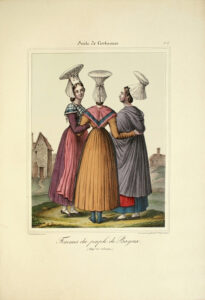Nantes, Charpentier, [1829-1831].
Large 4to [350 x 257 mm] of 88 lithographed and hand-colored (out of 120) plates mounted on guards. Bound without the title leaf in green half-shagreen, blind-stamped fillets on the covers, spine ribbed and decorated with gilt patterns. Joint slightly rubbed. Contemporary binding.
Superb suite of costumes of men and women coming from many departments of France and more particularly of Brittany.
Colas, Bibliographie générale du costume et de la mode, I, 612; Vinet, Bibliographie méthodique, 2279; Lipperheide, 1195.
“Most of these plates are lithographed by H. Charpentier, they are very interesting for the regional and rural costumes of France.” (Colas).
The lithographs have been executed by Henri Charpentier, and finely contemporary colored. A number of plates have been enhanced with gold in the costumes.
With landscape backgrounds these plates are very precious documents for the history of traditional costume in France and more particularly in Brittany: farmers, fishermen and newly married couples are mixed with ladies. The very famous traditional headdresses are represented in a very lively context.
The following departments appear in the present collection: la Vendée (6 pl.), le Maine et Loire (6 pl.), la Loire inférieure (18 pl.), le Morbihan (3 pl.), le Finistère (15 pl.), l’Ile et Vilaine (2 pl.), les Côtes du Nord (2 pl.), la Manche (3 pl.), la Seine inférieure (10 pl.), le Calvados (3pl.), la Charente inférieure (6 pl.), la Vienne (1 pl.), l’Indre et Loire (1 pl.), l’Eure et Loire (2 pl.), le Rhône (2 pl.), le Loiret (1 pl.), la Gironde (6 pl.), l’Ain (1 pl.).
“This set of plates is the earliest work devoted to the costume of the Bretagne region, as well as being of the highest quality”. (The Exotic and the beautiful, III, n°921).
The Charpentier’s, settled in Nantes, were very important Breton editors from the middle of the 19th century. They published a series of works on the region and used a new technique introduced in Nantes in 1821: lithography.
A very pretty collection of 88 lithographs finely hand-colored at the time, a genuine testimony of the clothing customs in Brittany and in France at the very beginning of the 19th century.

![[Recueil des costumes de la Bretagne et des contrées de la France…].](https://www.camillesourget.com/wp-content/uploads/2023/03/charpentier-pl4-web-8wJ0Y.jpg)
![[Recueil des costumes de la Bretagne et des contrées de la France…]. - Image 2](https://www.camillesourget.com/wp-content/uploads/2023/03/charpentier-pl4-web-dHv5y.jpg)
![[Recueil des costumes de la Bretagne et des contrées de la France…]. - Image 3](https://www.camillesourget.com/wp-content/uploads/2023/03/charpentier-pl3-web-GtGSJ.jpg)
![[Recueil des costumes de la Bretagne et des contrées de la France…]. - Image 4](https://www.camillesourget.com/wp-content/uploads/2023/03/40-charpentier-pl2b-web-zAaIg.jpg)
![[Recueil des costumes de la Bretagne et des contrées de la France…]. - Image 5](https://www.camillesourget.com/wp-content/uploads/2023/03/40-charpentier-pl-web-Xn37a.jpg)
![[Recueil des costumes de la Bretagne et des contrées de la France…]. - Image 6](https://www.camillesourget.com/wp-content/uploads/2023/03/charpentier-rel-web-qXKBm.jpg)
